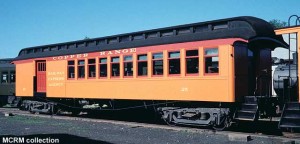Combination Car, American Car & Foundry, Lot 2504, February 1903

This wooden car was built by American Car & Foundry in 1903, as coach #59 (one of six identical cars numbered 55-60, including sister car Copper Range #60, also at Mid-Continent) for the Copper Range Railroad (CRRR). The coach was originally delivered in a color described as a green, brighter than Pullman green and striped in gold. The interior of the coach was originally stained and varnished with a Golden Oak finish. In addition to solid oak woodwork, the car had oak veneer headlining and ceiling panels. The seats were upholstered with cane (rattan). Heat to the car was provided by steam from a locomotive, while lighting was provided by four 2-burner kerosene lamps mounted on the ceiling.
Copper Range rebuilt the #59 into a combination baggage/coach in 1913, and renumbered it #25. In 1963, Mid- Continent purchased the car from Copper Range and it was moved to the museum’s new site at North Freedom. The car was quickly restored to the standard Milwaukee Road orange and maroon paint scheme adopted by the Copper Range in 1911, and used in the museum’s regular passenger train until the early 1970s when the steel Lackawanna coaches were brought onto the property.
In 2013, #25 was masterfully restored back to its 1913 appearance both on the interior and exterior following a five year restoration process. The exterior restoration included rebuilding both end platforms, reproducing the original buffers, replacing the steps, repairing the trucks and painting the car. A significant effort was required with the interior restoration as the original seats had been
removed from the car some 70 years ago. Great efforts and expense were taken to reproduce the original patented American Car & Foundry seats for the car. In addition, all new oak veneer ceiling and headlining panels, complete with gold leaf striping, were reproduced to replicate
what was originally in the car.
The Copper Range Railroad, the last major railroad built into the Copper Country of Upper Michigan, enjoyed a brisk, although short lived, passenger business that required some thirty passenger car over the years. Maximum trackage operated by the Copper Range never exceeded 150 miles but its passenger trains ran the gamut from the vestibuled “Northern Michigan Special” with the CRRR’s own cafe-observation car to the lowly locals serving the various mining communities on the “Range.” Considerable equipment was needed to handle the special weekend excursion trains from Calumet and Houghton to the Copper Range’s own Freda Park, a beautiful natural park along Lake Superior.
Beginning in 1911, the Copper Range passenger equipment was gradually repainted in the standard “St. Paul” (Milwaukee Road) scheme of orange and maroon. This change took place after the “Northern Michigan Special” inauguration as a premier Milwaukee Road passenger run from Chicago to Calumet. Its route included Copper Range trackage from McKeever to Calumet. Passenger service on the Copper Range dwindled to but a few mixed trains by 1930. The Copper Range Motor Bus Co. formed in 1928, plus the new family automobile both contributed to a dramatic decline in passenger business.
A small roster of coaches endured the Great Depression and served the Copper Country on the well remembered school trains. The Copper Range, beginning in 1908, carried school children to various area schools such as Painesdale from remote mining settlements of Redridge, Beacon Hill, Freda, Atlantic, and South Range. Most of the school train service was replaced by busses in 1941. Surplus coaches such as sister cars #55, #57 and two others, went to Mexico in 1944.
The last hurrah for Copper Range passenger service came in June 1, 1944 when a first class passenger train was re-instituted from Houghton to McKeever for a connection with the Milwaukee’s “Chippewa” to Chicago. World War II gas rationing made such service a necessity. The train consisted of Copper Range 2-6-0 #58 with wooden combination car #26 (sister to the #25) and coach #60. Both cars were completely refurbished for the new train. Unfortunately, the last vestige of Copper Range passenger service ended abruptly on September 15, 1946. The Copper Range was abandoned in 1973.
The American Car & Foundry Co., of Jeffersonville, Indiana had its beginnings as the Ohio Falls Car Co., being established during the Civil War. Ohio Falls endured several bankruptcies and the Panic of 1873 to become a major Midwestern car builder. Early on the firm promoted use of Southern Yellow pine for car construction due to its superior strength. By the 1890’s Ohio Falls’ volume had reached $3 million worth of cars annually. In 1899 Ohio Falls was consolidated into the industry giant American Car & Foundry Co. (AC&F). The Jeffersonville plant was closed by AC&F in 1945 although most of the buildings survive, utilized for a variety of industrial and commercial purposes.








